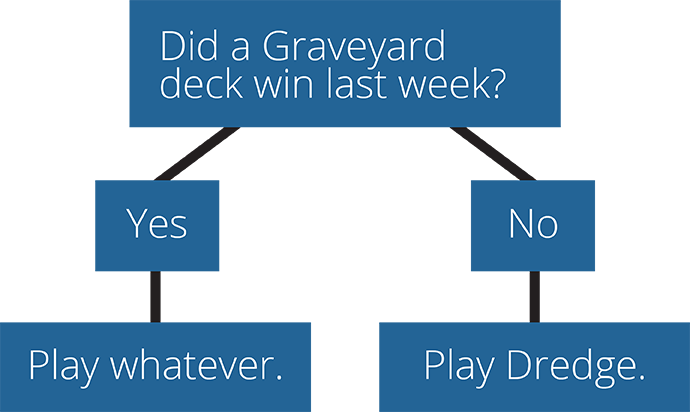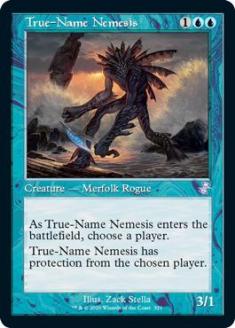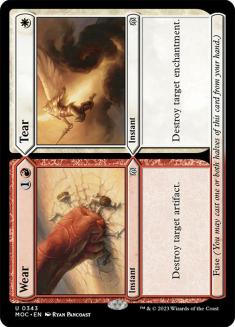Unless you’re from the Midwest PTQ circuit circa 2009, you probably don’t know who I am. My name is Adam Boyd, and I’ve been playing Magic competitively since the original Mirrodin and qualified for my first Pro Tour in Lorwyn block. Since then I’ve won a couple more PTQs and had some mild success when the SCG Open Series has been around my neck of the woods, including a Top 8 at the Legacy Open in St. Louis last weekend.
I don’t get to play Legacy very often, but I always enjoy myself greatly when I get the opportunity. I have a Top 8 with Dredge, an Invitational Top 8 with Merfolk, and some near misses with various strategies like Counterbalance and Goblins. I like playing a wide variety of strategies, and that’s one of the things I love about Legacy—as long as your list is tuned, you can play basically whatever kind of strategy you want and be successful with it. Unlike Standard, you cannot possibly be prepared for everything that is going to get thrown at you in a nine-round event, and you’re therefore advantaged by having the ability to adapt to new and unexpected decks on the fly, which is something I believe I excel at.
When choosing a Legacy deck, I use the following flow chart:

Dredge hasn’t made the Top 16 since the start of this year, which makes now the perfect time for it to make a comeback. I made plans to play the list Drew Levin suggested in his article last month and was very excited about the prospect of Golgari Grave-Trolling people. Things ended up not going quite as planned but luckily, like I said before, it doesn’t really matter what you play if you pilot it well and can adjust to the unexpected.
What I ended up registering was essentially the same U/W/R Delver deck that Owen Turtenwald picked up his first Grand Prix trophy with in Washington DC late last year.
Creatures (10)
Lands (20)
Spells (30)

The only changes I made were to cut a Meddling Mage and a Grim Lavamancer for two copies of Ethersworn Canonist. If I were to play the deck again, I would leave the maindeck alone, but I would probably mess around with the sideboard. I noticed that the sideboard is highly skewed toward combo and control matchups and has very little for creature-based decks like Death and Taxes and Elves. I know I want the second Grim Lavamancer back in and probably the last True-Name Nemesis as well over the Canonists, which are really overkill in the matchups where they’re good. This would give you at least four cards to sideboard in for those specific matchups so you can cut your Spell Pierces.
Now that that’s out of the way, it’s time to move on to what I really want to talk to you guys about:
Playing scared, playing scary, and being able to adapt.
I realize this could mean any number of things, and I will illustrate what I mean with matches from this past weekend.
Adapting
I had the pleasure of being paired against Sam Elfanbaum in the first round, and boy did he have some surprises ready for me. He led off with a Sandstone Needle, and when I picked it up to read it, he chided me with the standard, "We got a reader!" I then Wastelanded his double land and played a Stoneforge Mystic, getting a Batterskull. For the rest of the game, he just played three Mountains before succumbing to a Brian-Braun Duin Germ token.
It’s hard to sideboard against a deck when you don’t see any spells out of it and it isn’t immediately obvious what your opponent is playing. In situations like this, I like to make an educated guess about what they might be playing and sideboard for that as long as it won’t hurt me too much if I’m wrong. For example, if Sam had played Saprazzan Skerry and Islands, I would have felt safe bringing in a few copies of Red Elemental Blast since they’re going to be good regardless, but I wouldn’t have brought in Ethersworn Canonist even though he might have been playing some kind of High Tide deck. When I’m up a free game like in this example, it’s easier to justify the safe play of not messing around with your deck too much.
My guess was that he was playing some kind of All-In Red deck or a budget Grindstone deck. With those on my mind, I didn’t want to cut any of my removal or counterspells, but I felt safe cutting True-Name Nemesis since it would probably be pretty slow. I boarded very conservatively.
Out:
In:
I found out what Sam was actually playing during the second game. In the midgame, he locked me out of one-mana spells with a Chalice of the Void and Pyroclasmed my fresh Stoneforge Mystic. Thankfully, I got to five mana, played Batterskull, and started beating down against his board of a bunch of Ancient Tombs and Sandstone Needles, Simian Spirit Guide, Lotus Petal and the aforementioned Chalice. I kept putting lands into play (some of which were Wasteland), but I figured he had more than enough mana to do whatever he was ramping for, meaning I might as well keep them in case I needed to pick up and reset Batterskull.
I felt safe. And that’s when Sam dropped the hammer and revealed what he was really about.
He tapped all his lands and cast a Seething Song into a Blightsteel Colossus, and with his Lotus Petal left open, I couldn’t Daze it. Right then I realized what I probably should have realized sooner—he was a Sneak Attack deck. Even if I had figured it out sooner, I probably wouldn’t have guessed he had Colossus in his deck and probably wouldn’t have Wastelanded him to keep him off the mana he needed to hard cast it. My Germ was able to buy me a turn to search for a Swords to Plowshares, but I didn’t get there.
Now I got to go back to my sideboard with more information. I hadn’t seen a Sneak Attack, but I was pretty sure that’s what was going on, so I cut Lightning Bolt and brought in Sword of Feast and Famine and Meddling Mage.
Game 3 I got to Meddling Mage Sneak Attack and Pyroclasm while he just had two copies of Ancient Tomb and a Crystal Ball (have we got a reader?) in play. When he got to seven mana, Sam played Chalice of the Void for one, and even though I had a bunch of spells in my hand that it would shut off, I also had a Force of Will, a Daze, and lethal combat damage in three turns (less if he used Ancient Tomb), so I let it resolve. Then he went for Through the Breach, and I was able to Daze it to pretty much put the match away since I could follow up by attacking Sam down to two and turn off most of his mana. After the game, he revealed he did have a Sneak Attack in hand, so it felt good to get that one right.
Playing Scared & Playing Scary
The idea of playing scared was taken to an extreme in my round 5 match against Mariah Guzman. On her first turn, she Gitaxian Probed me and saw that I had Force of Will, Spell Pierce and Daze along with some lands and a Delver of Secrets. Over the course of the next six turns, she just drew and discarded cards like Elvish Spirit Guide and Desperate Ritual without ever playing a land or another spell. Eventually she died to my single Delver and double Lightning Bolt without over casting anything besides the Probe.
While we were sideboarding, she apologized to me. "I’m sorry I didn’t play any spells that game. I was just really scared."
We have all been in a situation where we know they probably have that one spell that is going to blow us out, but most of the time you just have to go for it and make them not only have it but play it correctly. You just cannot play scared in this way, as it’s not going to lead to a win (which is the goal after all). That being said, there is another way of playing scared that I think people do far too often:
Feigning weakness or strength.
Sometimes these can be useful tools, but it doesn’t happen nearly as often as people think. So many things have to go right for a bluff like this to work. First, the right situation has to arise where you could gain an advantage if your opponent thinks you have nothing. Then you have to put on a Cranston-esque performance, which if we’re honest is probably going to be more like Shatner. Finally, they have to actually believe the person that is sitting across from them and figuratively trying to kill them. There’s the old adage that you can’t bluff someone who doesn’t know what’s going on, and if you try it on someone who does, you’re really playing with your hand face up.
The inverse of this is what I call playing scary, and that’s posturing to look like you have something when you really don’t. It’s even easier to see through and harder to pull off because people are just going to go for it anyway even if they do believe you because they have to. What else are they going to do—not cast any spells?
I’ve found that giving your opponent misinformation can be way more dangerous than giving them no information at all. It’s like my buddy Ender Wiggin said: "Sometimes lies were more dependable than the truth."
Instead of playing scared or scary, what I suggest you do is play stoney. You know, like a rock? Robot, maybe? A soulless, emotionless being? Whatever you want to call it. Just give them stone nothing.
Are you happy with what you’re holding?
Are you worried?
Do you have it?
Do you not?
Who knows? Take a wild guess. Flip a coin.
The problem here is that this is hard to pull off for some people and any little crack can give it all away. If you would rather, you can just always posture one way or the other to give a similar effect.
Always strong or always weak will also give them no discernable information. For an example of this, go watch Samuel Estratti play in the Top 8 of Pro Tour Philadelphia 2011. Throughout the entire thing, it seems as though his internal organs are failing him, or maybe it’s that his opponents are kicking him in the shins under the table. Whatever it is, he looks as if he is in immense physical pain at the draw of each card.
Now, Estratti is a brilliant player who pulled off one of the biggest and most impressive bluffs I’ve ever seen at a Pro Tour, and he was no stranger to high-level Magic even though that was his first Top 8. I find it hard to believe he was actually in the mindset that he seems to be and doubt any of his opponents did either, but I also find it hard to see what is actually going on in his head. So by all means, if it’s easier for you groan and wince your way through all your matches than it is to keep on a straight face, then go for it.
This isn’t to say that you should be cold and not speak to your opponents. You should obviously be friendly to everyone, but you probably shouldn’t be sighing loudly and shaking your head when you draw a card as often as you might be. There are plenty of more convincing and effective bluffs out there that you can run that don’t rely on your acting chops.
After all, Magic is a game of information. Don’t give them any for free.



